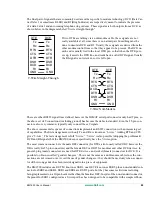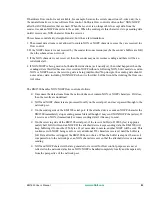
EM1500 User’s Manual
91
bit time. This is known as the “stop bit” and is required so that the receiver can reliably synchronize on the
next start bit. Synchronization is always required on the start bit, since there is no separate clock signal: the
clock must be reset at each start bit.
The resetting of the receiver clock at each start bit allows sender and receiver to have slightly mismatched
bit rates. A difference of up to about 2% can be handled.
The above description applies to the most common protocol, known as 8N1 or 8 data bits, no parity bit, 1
stop bit. Other formats are similar except that they optionally add parity or more stop bits, and optionally
allow fewer data bits. The EM1500 supports all 7 and 8-bit data formats, with one stop bit and optional
parity.
The bit rate, sometimes loosely referred to as the “baud rate,” may be any value but is usually selected
from a small range of discrete rates such as 600, 9600, or 57600 bits per second. The EM1500 supports all
standard rates between 75 and 230400 bps, plus many non-standard rates.
At high bit rates, it is quite likely that the receiver will run out of buffer space if it is not fast enough to pro-
cess that data in a timely manner. There needs to be some way of signalling the sender to temporarily stop
transmitting. This process is known as “flow control.”
B.1.4 Flow Control
Flow control is an important consideration. If it is not properly defined for an application, then data loss
can result. Flow control works independently in both directions of a full-duplex link.
There are ways of performing flow control, with greater or lesser performance. In the simplest case, there
is no flow control at all. This means that data in excess of the receiver's buffer capacity is simply dis-
carded. It is then up to the higher level application to realize that data has gone missing.
When a 3-wire link is in use, the only alternative is to insert some special signalling in the opposite direc-
tion. Most commonly, the ASCII characters XON and XOFF are used to start and stop the other end's
transmitter. Whether this works or not depends on whether the XON and XOFF characters can be confused
with the same characters in the normal data stream. In general, this limits XON/XOFF (also known as soft-
ware flow control) to ASCII data streams, as opposed to binary data streams where XON and XOFF have
no special meaning, and can occur by chance.
The best solution is to use hardware flow control. This means that at least a 5-wire link is required. Most
commonly, the RTS and CTS modem control lines are used. The convention is that when the RTS or CTS
input is not asserted, the device will cease transmitting until the line is asserted once more.
Rather than RTS/CTS, other lines can be used (i.e. DTR/DSR) but this is rare. The EM1500 supports all
these methods of flow control. Unlike most devices, the flow control method can be set independently for
each data direction. For example, the EM1500 could be using CTS to pace the incoming data from a
device on SER2, whereas the device could be using XON/XOFF to pace data being transmitted from the
EM1500.
B.1.4.1 EM1500 Flow Control Specifics
The EM1500 supports flow control at several points in the data transfer sequence. The most visible point is
the serial port itself. The next point, which is handled completely automatically, is when the data is trans-
ferred to the network. Finally, there may be end-to-end flow control mediated by the application and
device at each end of the connection. End-to-end flow control is not (and cannot be) of interest to the
EM1500, for it has no knowledge of application-level protocols. An example of end-to-end flow control is
Summary of Contents for EM1500
Page 14: ...10 www rabbit com Introduction...
Page 22: ...18 www rabbit com Getting Started...
Page 76: ...72 www rabbit com EM1500 Configuration...
Page 90: ...86 www rabbit com EM1500 Specifications...
Page 104: ...100 www rabbit com Serial and TCP Protocols...
Page 118: ...114 www rabbit com EM1500 FAQ...















































